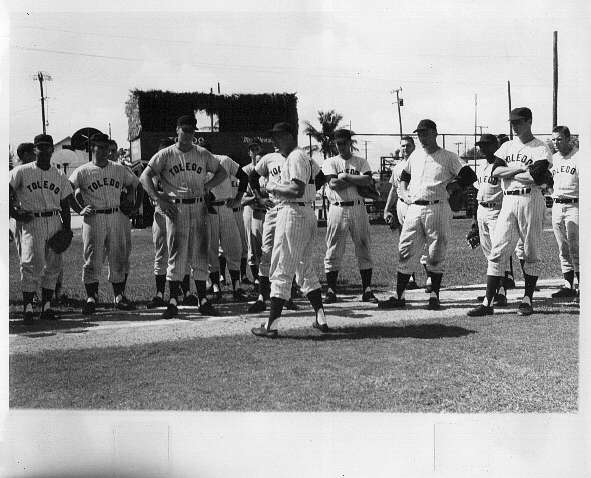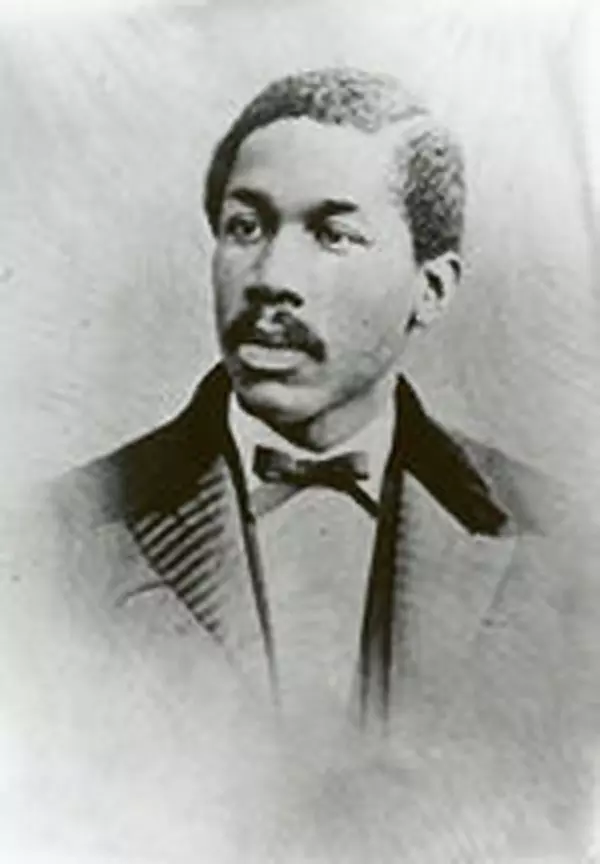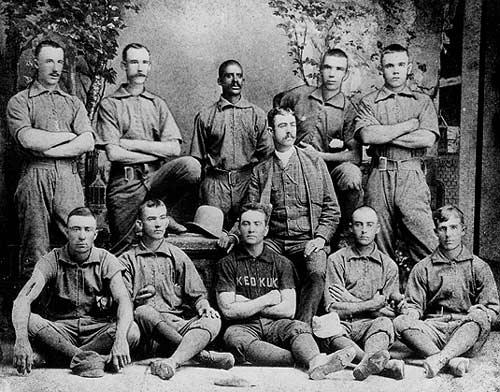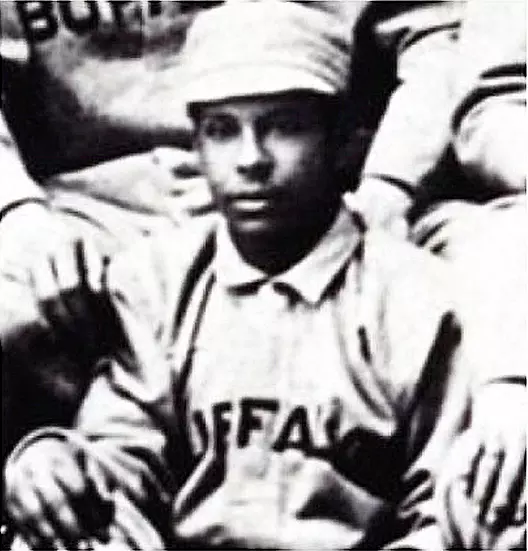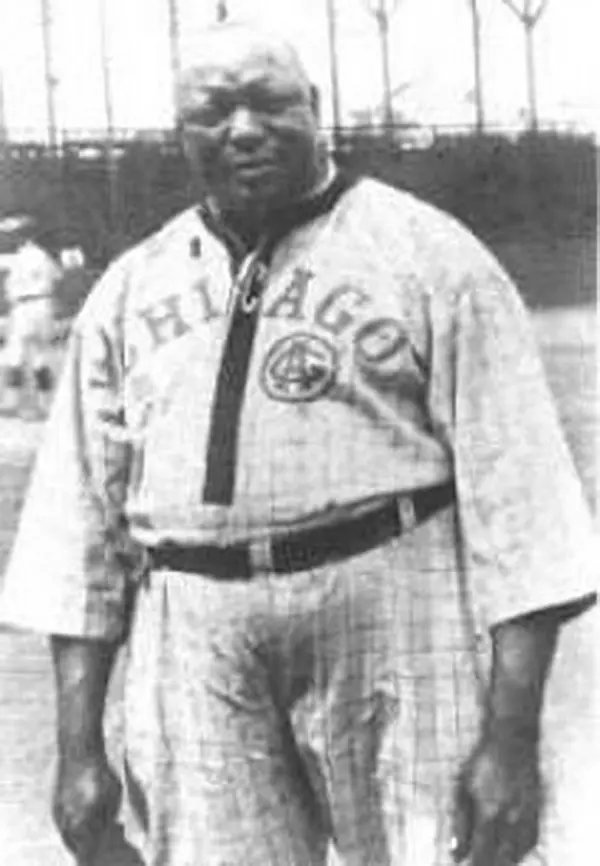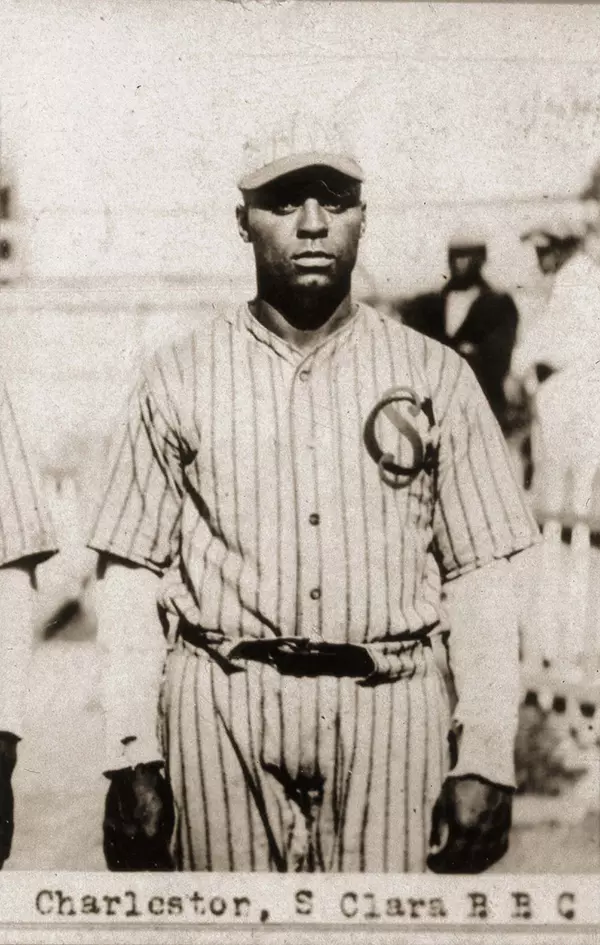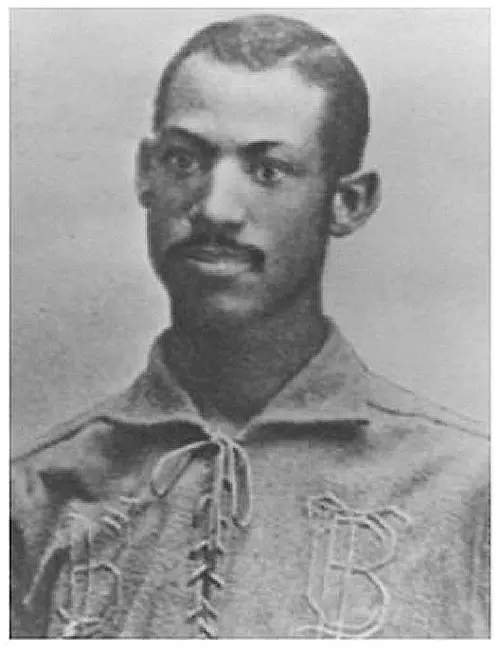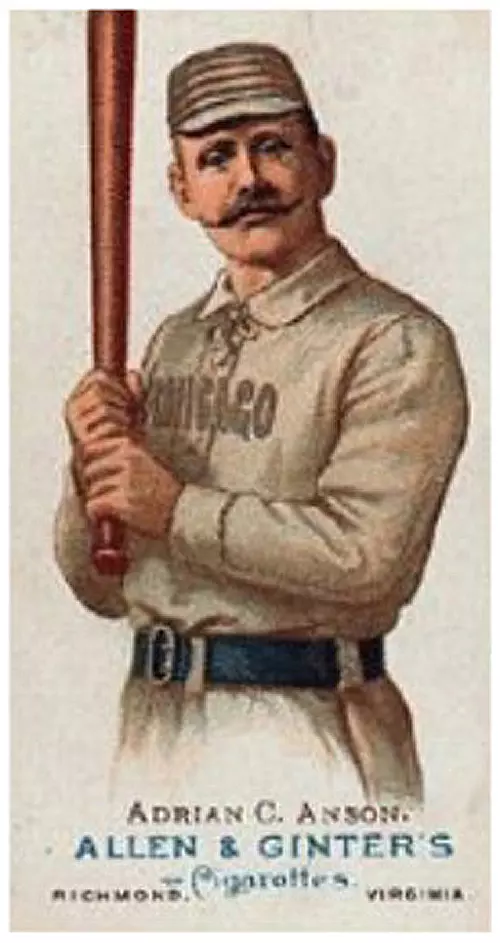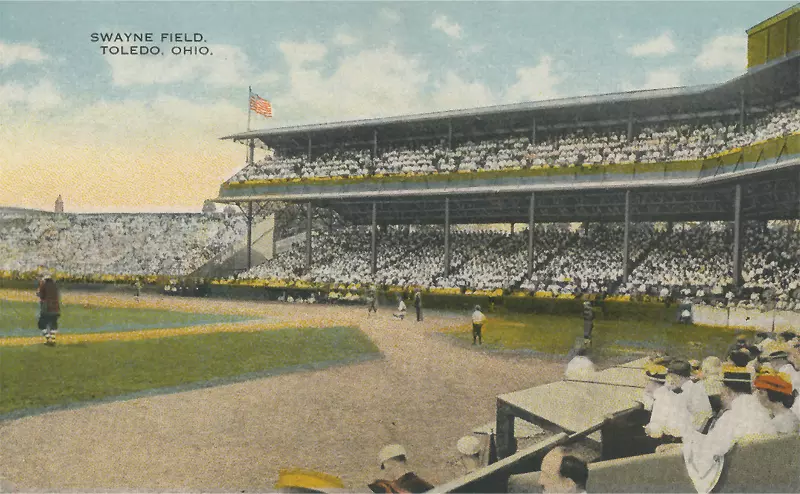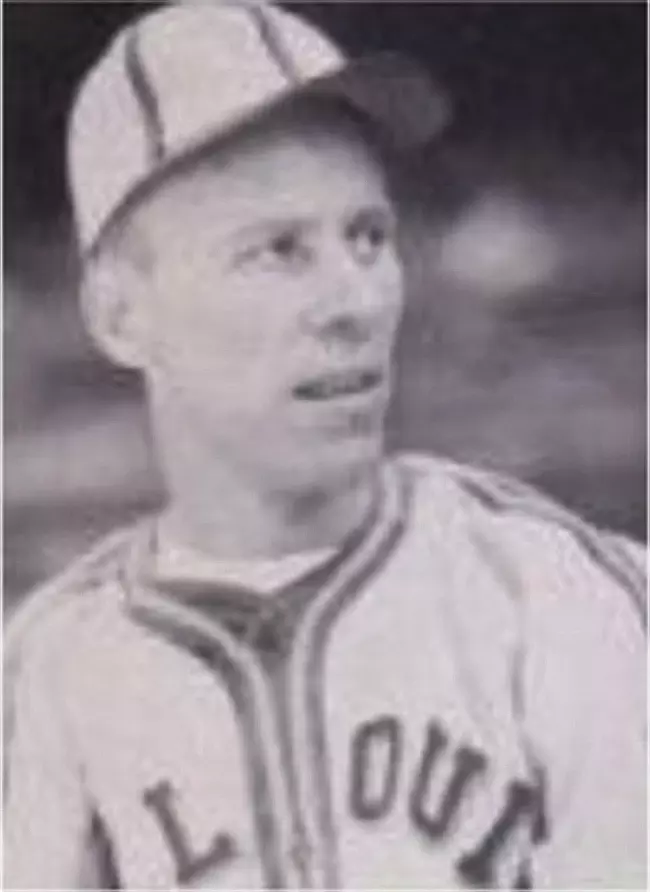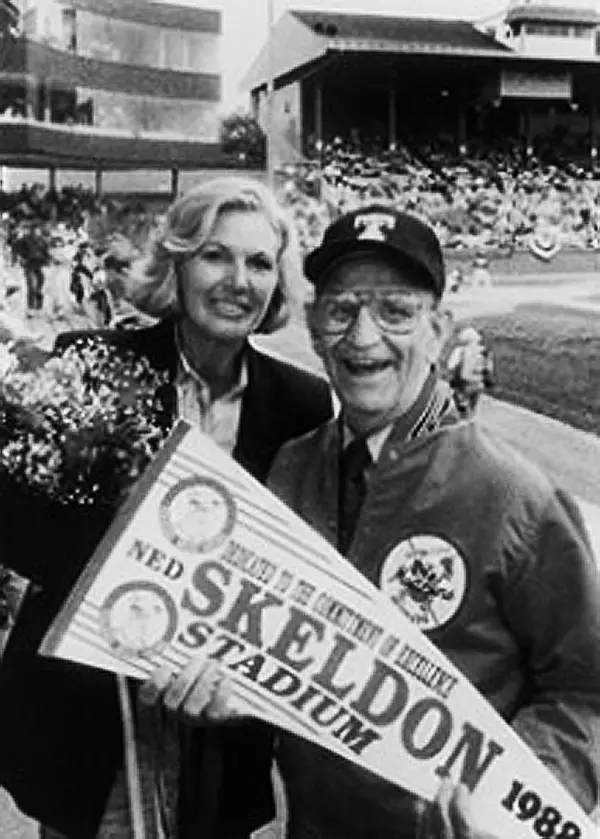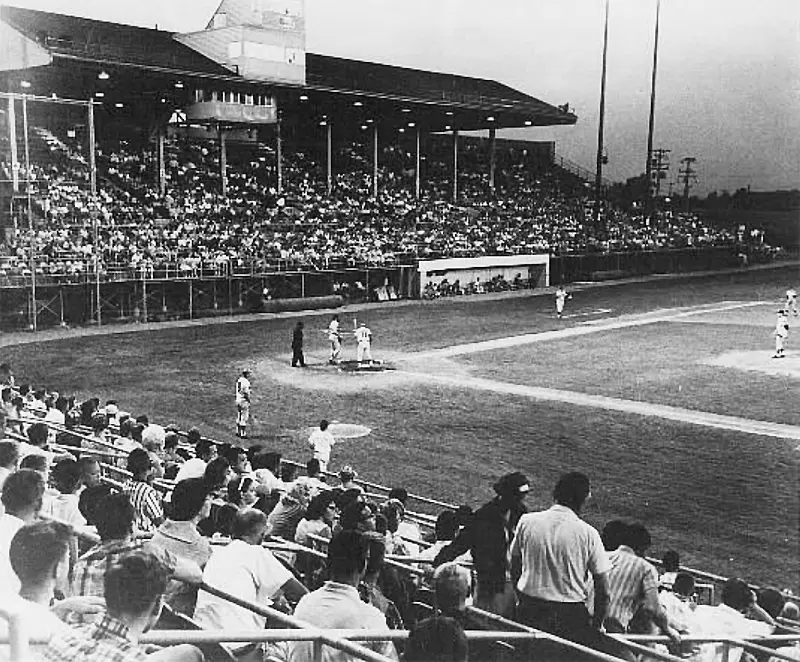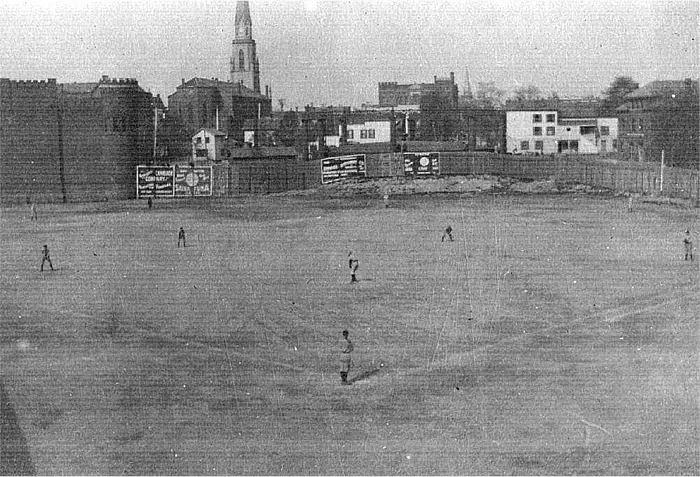 Armory Park
Armory Park
Exhibit Gallery









































The Toledo Mud Hens have had a long and storied history in Northwest Ohio. The club has pushed the color barrier when other teams were trying to exclude African American players, served as training grounds for future Hall of Fame players and managers, and has seen revitalization recently with two consecutive championship seasons.
This exhibit highlights the history of the Toledo franchise, from its humble beginnings as Toledo men's league team to its bright future in modern Fifth Third Field.
Toledo and the Negro Leagues
From Moses Fleetwood Walker to the Crawford and Cubs of the Negro Leagues, Toledo was a friend to African American baseball for nearly 60 years. This is the story of African American professional baseball in Toledo from 1883 until the “breaking” of the color barrier by Jackie Robinson in 1947.
In no way is this essay intended to be a definitive look at the long and storied history of the Negro Leagues in the United States. The focus is on the brief but rich history of African American baseball in Toledo, Ohio, with a brief background on the history of African American baseball in the United States. Excellent resources on the history of the Negro Leagues can be obtained by contacting the Negro League Baseball Museum.
Roots of the Negro League: Roots of Baseball and the Color Line
Baseball would follow the lead of boxing and other sports as beginning racially divided after the Civil War ended in 1865. Base ball (originally two words) had grown out of cricket and other sports in the mid nineteenth century, with its first recorded contest taking place in 1845. The first recorded African American game would be played 16 years later, when the Colored Union Club of New York lost to Weeksville (NY) 11-0. At this point, base ball was not a professional sport (the Reds of Cincinnati would be formed in 1869), with the teams and rules changing from game to game.
Even before the Reds became the first professional franchise in 1869, “blackball,” African American amateur leagues, was prevalent on the east coast. One of the major figures in black baseball was Octavius V. Catto, a retired Army major and teacher at the Institute for Colored Youth in Philadelphia. Catto, a fiery speaker and champion of equal rights for African Americans, fought with the then-union of baseball, the National Association of Base Ball Players (NABBP), to include African American players in their ranks. Although the NABBP would later vote to not allow teams "which may be composed of one or more colored players" to play "organized" base ball, Catto, the owner of the Pythians, would continue to field his Philadelphia-based “blackball” team against any team that would play them, black or white.
After fighting the NABBP, Catto tried to use his increased political presence for a greater good and set his sights on equal voting rights for African Americans in 1871. This move would prove to be quite incendiary in Philadelphia, setting off riots throughout the city that prompted US Marine intervention to keep the peace. During this turmoil, Catto was accosted by a white male after leaving the Institute for Colored Youth and was shot and killed. The shooter was detained temporarily and then released and no charges were brought against him.
The 1871 murder of Catto not only ended the life of an early great civil rights activist, it also brought the "blackball" era to a halt. Passing away along with Catto and his beloved Pythians were the gains that Catto was able to make in securing African American equality in the new booming sport of base ball. The Pythians and other ballclubs lost direction and folded within a year of Catto's death, bringing to a close an early chapter in the development of the Negro Leagues.
From Catto to Fleetwood
Even though the murder of Catto brought the progression of African American baseball to a standstill, some players were still able to make a living playing the game. One player in particular was Bud Fowler.
Born John W. Jackson, Fowler began his career as a pitcher in 1878, spending his brief pitching career with various teams throughout the Northeast. Fowler would later make his mark as a second baseman for the Keokuk, Iowa franchise of the Western League, playing several more seasons before the color line in baseball became more cemented. When Fowler's playing career began to wind down due to age and racial issues, he moved into organizing and managing African American teams, including the Page Fence Giants (Adrian, MI) of the Michigan League and the Cuban Giants in exhibitions against the professional Cincinnati Reds. Fowler would later manage other ballclubs such as the Smoky City Giants, the All-American Black Tourists, and the Kansas City Stars.
The first African American to play major league baseball was former Brown University student William Edward White, who played one game for the Providence Grays in 1879. White, who is also thought to be the first and only former slave to have played major league baseball, went 1-4 in his only game, making 12 put outs, scoring a run, and striking out once.
The man long thought to be the first African American player in the major leagues was Toledo Blue Stockings catcher Moses "Fleetwood" Walker. Fleet, as he was known, was a member of the Toledo franchise that spent a single year in the professional American Association. Although Fleet's play on the field was noteworthy, it was his dealings with Cap Anson, the future Chicago White Stocking Hall of Famer, that made him famous. Anson never forgot the 1884 incident in which he was rebuked when he attempted to get Walker off the field due to his race. When the two were scheduled to meet again on the field in 1887, this time with Walker playing for the Newark franchise. Fleet and George Stovey, the talented pitcher who holds the International League season win record with 35, once again drew the ire of Anson. This time, without Toledo and Charles Morton for protection, the International League, (led by the six teams that did not have black players), voted 6 to 4 to create an unofficial color barrier.
By the end of the 1889 season, the International League was an all Caucasian league, with Fleet Walker the last African American to play in the league. Stovey would later play in other minor league systems, as well as with the all-black Cuban Giants, but never would he make it to the major leagues. Walker would never play baseball again after the 1889 season, moving back to Steubenville to join his brother in several business ventures and to advocate a return to Africa for all blacks in the United States to end the racial divide.
Another great of the time relegated to the minor leagues due to the racist policies of the National League was Frank Grant. Grant, a second baseman for various franchises, was considered by most to be a Major League talent, but spent most of his career in the International League, eventually finishing with the Cuban Giants due to the new color barrier. Grant would eventually be voted into the Major League Hall of Fame for his talents in 2006.
By the end of the 19th century, blackball had returned, this time as more of traveling minstrel than baseball teams. Although teams such as the Page Fence Giants of Adrian, MI and the New Orleans Pinchbacks were filled with potential Major League talent ballplayers, they were forced to include gimmicks in their games – such as juggling or other routines – in order to entertain their fans. The gains made by serious professional ball players such as Bud Fowler, Fleet Walker, and Pythians owner Octavius Catto were put on hold until a new professional league could be created.
The Birth of the Negro Leagues
After another dozen years of constant barnstorming, talk of an all-African American league began to bubble to the surface again. With more and more southern African Americans moving to northern factory towns, a larger fan base emerged for the league.
The main benefactor of this new league would be former Cubans pitcher Andrew "Rube" Foster. Foster would later rise to prominence and fortune within the league, sometimes commanding 40% of the gate receipts for his teams’ barnstorming games.
During the first years of the 20th century, Foster was able to make the Leland Giants, the team formed from the Chicago Union Giants, into the best African American team. Well aware that most of the barnstorming teams were run and operated by rich white businessmen, Foster desired to have the operations turned over to blacks.
With the continued rise in the black population of the North, Foster, along with trusted white All Nations traveling team owner J.L. Wilkinson, set out to build a sustainable all-black baseball league. In 1920, with the First World War over, Foster got his wish and the Negro National League was formed in Kansas City. Although the league would never rise in prominence to compete with the major leagues, even folding briefly in 1933, the dream of Catto and Foster of an all-black professional baseball league had finally been realized.
Toledo Crawfords and Tigers
Toledo, Ohio had a brief history of involvement with the various incarnations of the Negro Leagues. All of the teams that played in Toledo were able to use Swayne Field, at the time one of the best facilities in all of the various minor leagues.
The first Negro League team to play in Toledo was the Toledo Tigers. The Tigers took the field for their one and only season in 1923, playing in Swayne Field with limited success. The team, made up of semi-pro players and remnants from the Cleveland Tate Stars, lasted most of the 1923 season, finishing with an 11-17 record. The team was disbanded in July of that season, with their players disbursed to the St. Louis Stars and Milwaukee Bears. The fans of the Tigers were treated to seeing Negro League great Bill Gatewood manage the first part of the season, with Candy Jim Taylor finishing the season as the skipper.
The African American community of Toledo would get another Negro League team in 1939, when the Crawfords arrived from Pittsburgh. The Crawfords, owned by Gus Greenlee, were unable to stay financially solvent and in 1939 were forced to leave Pittsburgh for Toledo.
The Crawfords, named for a tavern in Pittsburgh, did not fare well in Toledo either, playing only 19 games at Swayne Field under the management of Oscar Charleston, who was also the first baseman. The highlight of the shortened season for the Toledo fans was witnessing Tommy Dukes, a well known journeyman player, hitting .385 for the transplanted Crawfords.
Unfortunately for Toledo, the team was still not financially viable and folded at the end of the 1939 season.
Turbulent Years, 1880-1900
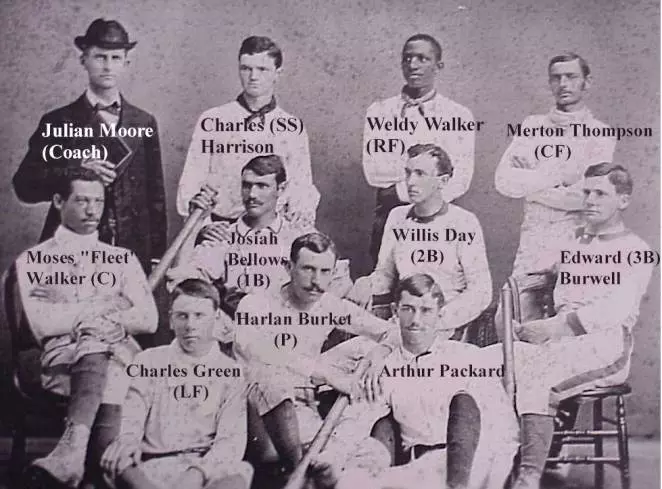 Team portrait at Oberlin College with Moses "Fleet" Walker
Team portrait at Oberlin College with Moses "Fleet" Walker
Base ball (originally two words) had already become well established in Northwest Ohio prior to the formation of the "professional" Toledo Base Ball Association in 1883. The league was made up of ten ball clubs and included Noah H. Swayne, a Toledo area businessman, in its ranks.
The rules of base ball in the 1880s were slightly different than the rules that we know today. Walks, which now come after the fourth non-strike, were allowed after seven. Overhand pitching was illegal and stolen bases were not allowed.
In the first years of Toledo professional base ball, the results were mixed. The first professional game played in the city was won by the Toledo Blue Stockings 5-4 over Bay City on May 5, 1883. The 1883 Blue Stockings would go on to win the Northwestern League pennant under manager Charles Morton.
Following the Cap Anson incident (see next section) at the end of the 1883 season, the Blue Stockings began play in 1884 in the American Association of the major leagues. Major League baseball was growing by leaps and bounds in the 1880s, with games being played in more than 30 cities in 1884 alone. This jump in competition proved to be too much for the newly named Toledos and they finished the season in eighth place, well out of the running for the pennant. Major League baseball’s run of good fortune ended and by the end of 1885, so had the run of Toledo baseball. The Toledos, now of the Western League, were contracted and baseball left Toledo for three years.
Baseball player and manager Charlie Morton returned to Toledo in 1889 with the Black Pirates of the International League. The Pirates played well enough in 1889 to secure an invite back to the American Association of the Major Leagues in 1890, finishing in a respectable fourth place and a couple games above .500 each season. But this would only last one season, as financial woes brought on by lagging ticket sales brought the Toledo franchise to contraction once again in 1890.
Baseball in Toledo refused to die in the 1890s, even in light of the Chicago World's Fair in 1892 and the stricter enforcement of Toledo’s "Blue Laws" forcing the team out of town or into bankruptcy twice in the decade. The 1896-1897 Swamp Angles/Mud Hens became a proven winner to close out the decade, taking the pennant in 1896 and 1897 and finishing no worse than third in from 1890-1900 under manager Charles Stroebel.
Notable players/opponents: Moses Fleetwood Walker, Cap Anson, Tony Mullane, Hank O'Day.
Moses Fleetwood Walker
Moses Fleetwood Walker was born in Mt. Pleasant, Ohio in 1857, the fifth child of Caroline and Moses Walker. The family moved to Steubenville so that the elder Moses could begin practicing medicine. Fleet, as he was known to his family, and his brother Weldy would attend all black schools until the city high school was desegregated.
After graduating from Steubenville, Fleet would go on to Oberlin College, a school known for its progressive admission policies towards blacks and women. Fleet took up baseball at Oberlin, and his obsession with the sport nearly caused him to flunk out. After starring for the newly created Oberlin baseball team, Fleet, Weldy, and Fleet's pregnant future wife all left to enroll at the University of Michigan in Ann Arbor.
After starring at Michigan and several stints with professional traveling teams, Walker joined the Toledo Blue Stockings and led them to the Northwestern League crown in his first season. Walker earned $2,000 for the 1883 season, a large sum for a player of any race at the time.
The end for Walker was near after the August incident with Cap Anson, one of many racist incidents that would follow Walker throughout his short career. Fleet, along with his brother Weldy, would play Major League baseball for one season with the new Toledo franchise, but the segregationist policies advocated by Anson derailed any advancement of Walker's career.
Walker would finish his minor league career with the Syracuse Stars in 1889. One evening, he was attacked by a group of white males. He was able to defend himself, killing one of the men in the process. After a long trial, Walker was found innocent and left New York to return to Ohio. Weldy, now a businessman back in Steubenville, invited his brother to come back to work with him. Weldy and Fleet would later run a movie theatre and hotel in Steubenville.
Outside of his business pursuits, Fleet also became a spokesman for Black Nationalism and Marcus Garvey. He wrote and published the Equator, a magazine on African American issues. In 1908, Walker published the pamphlet Our Home Colony: A Treatise on the Past, Present, and Future of the Negro Race in America, stating that "the only practical and permanent solution of the present and future race troubles in the United States is entire separation by emigration of the Negro from America."
Walker passed away in 1924 in Cleveland, Ohio.
Cap Anson Incident
The 1883 championship season also brought with it a fair share of controversy. The star of the Blue Stockings, Moses Fleetwood Walker, and his brother Weldy were both African American baseball players at a time when the color line in baseball was just beginning to be drawn.
After winning their first championship in 1883, the Blue Stockings were invited to play an exhibition game against the Chicago White Stockings. On August 10, the National League champs featured future Hall of Famer Cap Anson as a manager and player. At the time, Anson was in the prime of his career. Even though he had had an off season by his standards, Anson was still one of the most important figures in baseball.
When hearing that his White Stockings were scheduled to play against a team that featured an African American player, Anson stated that he would not set foot on the field if the Walkers played.
Although Walker was not scheduled to play his usual catcher position due to a hand injury (he did not use a glove), Toledo manager Charles Morton put Walker in the outfield after hearing Anson's racist comments. With the league's future still in economic limbo and fearing a loss of the gate receipts, the Chicago ball club and Anson backed down and played the game.
Although Morton forced Anson's hand and made him play against an African American player, Anson would have the final laugh as he is considered by most to be a leading force in the gentlemen's agreement that introduced the color barrier to baseball. After the Walkers and a couple other players retired, the game of baseball stayed predominantly segregated until Jackie Robinson broke through in 1947.
Mud Hens, Iron Men, and Soumichers, 1902-1926
The dawn of the twentieth century found relative stability and prosperity in Toledo baseball. The Mud Hens finished a strong third in the Inter State League during the first season of the new century under manager Charles Stroebel. Even with the folding of the Inter State league in 1900, the Mud Hens continued to play on in a new league that rose from its ashes, the Western League. The Mud Hens would move to the American Association in 1902, staying in that league until the team left Toledo in 1955.
 Armory Park: A photo of a baseball game being played at Armory Park, located off Spielbush Street in Toledo, Ohio.
Armory Park: A photo of a baseball game being played at Armory Park, located off Spielbush Street in Toledo, Ohio.
With the newfound stability of the American Association, it became obvious that Armory Park was no longer a suitable home for the franchise and that the team needed a modern stadium to play in. With this in mind, Swayne Field opened for play on July 3, 1909. The park, which was built on land donated by an old friend of Toledo baseball, Noah Swayne, was considered to be the "finest park in minor league baseball" at its opening. Toledo baseball would call Swayne Field home until 1955.
The Toledo franchise went through multiple owners during the early twentieth century. The first, J. Edward Grillo, a Cincinnati sports editor, tried to infuse the struggling franchise with a winning attitude. The franchise was able to rise out of the American Association cellar, even placing as high as fourth in 1906. The next owner was William R. Armour, the man credited with signing Ty Cobb in Detroit. Armour was able to turn around the struggling team in 1908, nearly taking the team to the American Association pennant. On the heels of this successful season, Armour, using land donated by Toledo businessman and former player Noah Swayne, built Swayne Field. Armour spared no expense in the construction of his state-of-the-art ballpark.
After the 1910 season, Armour sold the Mud Hens to Clevelander Charles Somers, who quickly moved the team to Cleveland in 1914 to block the expansion of the Federal League. The city of Toledo would be home to the South Michigan League Soumichers in 1914 and 1915, but low attendance due to the team’s poor play forced the Soumichers to play their home games on the road in 1915.
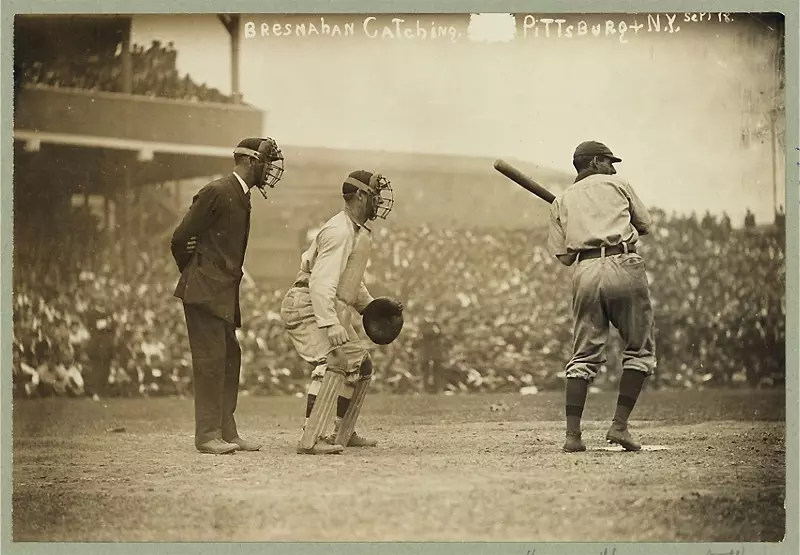 Roger Bresnahan, catching for the New York Giants
Roger Bresnahan, catching for the New York Giants
With the folding of the Federal League in 1915, professional baseball was brought back to Toledo by native son Roger Bresnahan. Bresnahan, who had left Toledo to become a Hall of Fame catcher for the New York Giants, retuned as owner; player; and manager of the newly named Iron Men. During Bresnahan's tenure the team improved instantly, winning 87 games in 1920 and barely missing the playoffs. This would be short-lived, as the team slipped back into its losing ways, finishing near last or last during the next five seasons. The team was still a decent draw due to the former and future Major Leaguers on the roster during this time, such as Jim Thorpe; James Middleton; Freddie Lindstrom; Hack Wilson; Dutch Schliebner; and Bill Lamar.
After 1902, the Toledo franchise suffered through two decades mostly of sub-.500 seasons, with the 1906; 1910; 1912; and 1920 seasons being the notable exceptions. All of this was soon to change with the return of Roger Bresnahan and the introduction of Casey Stengel as the new manager in 1926.
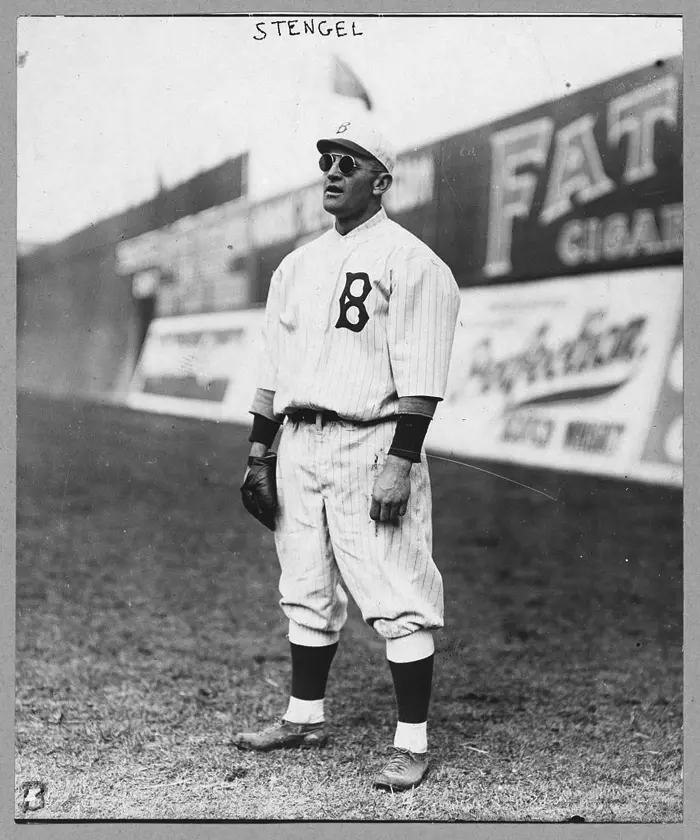 Casey Stengel, full-length portrait
Casey Stengel, full-length portrait
Champs to Chumps, 1928-1950
The 1927 team would prove to be the last championship Toledo team for more than half a century. The team would quickly be dismantled, with most of the major parts graduating to the Major Leagues in 1928 or 1929. After a second 100 loss season in 1931, Stengel left the Mud Hens to begin his Hall of Fame Major League manager career.
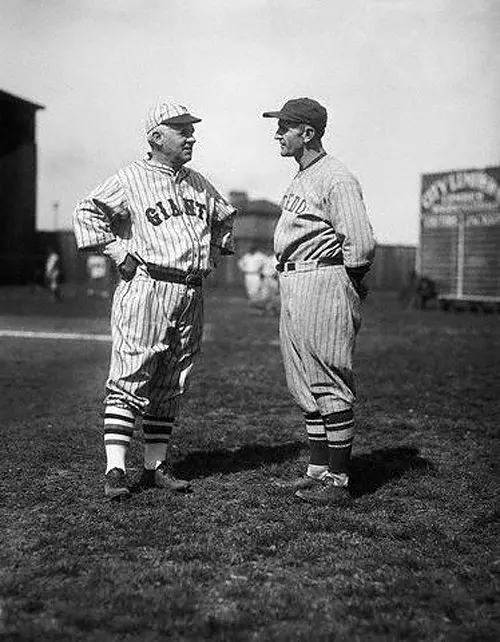 Toledo Manager Casey Stengel, (right), and Giants' Manager John McGraw (left), 1926
Toledo Manager Casey Stengel, (right), and Giants' Manager John McGraw (left), 1926
During the 1930s, the Mud Hens suffered through the Great Depression along with the rest of the country. At the beginning of the Depression, the team went into receivership in 1929, with local businessman Waldo Shank rescuing the team from contraction in 1929. Minor league baseball would have to turn to gimmicks, coupled with the excellent play on the field, to avoid economic extinction during the Depression.
The first gimmick was the introduction of night baseball. The idea was not a new concept, as the Negro League Kansas City Monarchs, in many ways pioneers of baseball, had been transporting portable lights during the various barnstorming tours of the United States. The Mud Hens would introduce night baseball to Toledo on June 23, 1933, defeating the Columbus Red Birds 2-1 behind the 15-strikeout performance of Monte Pearson in the inaugural night game. It would be almost two more years before the professional Cincinnati Reds would introduce lights to the Major Leagues.
Another gimmick, which has also worked more recently within all of the major professional sports, was the extension of the playoff season. Under the previous system, only the top two teams would make the playoffs to battle for the Junior World Series. Under the new Shaughnessy playoff system, four teams were now invited.
Another major innovation that was sweeping throughout minor league baseball was the institution of the "farm team" system. Toledo would have various Major League affiliates throughout the depression, beginning with the Indians in 1932 and also sending players to the Tigers and St. Louis Browns during the 1940s.
The 1930s and 1940s were not kind to the Mud Hens. After the surprising 1930 campaign, the team would finish under .500 in all but five seasons, finishing in last place most of those years. As could be expected, in the years when the team played poorly on the field, they also did poorly at the gate. This was evident in the 1936 and 1937 seasons. In 1936, the team finished a woeful 59-92 and drew nearly 70,000 fans. The next season, the team bounced back, finishing in second place and drawing almost 260,000.
The beginning of World War II brought a new role for baseball: morale booster. Even though Toledo and all of the other ball clubs lost players to the war effort (10 in both 1942 and 1943), baseball did continue. The teams put on the field by the Mud Hens did not fare particularly well, with only the playoff season (due to the Shaughnessy playoff system) of 1944, which was quickly followed up by sub-.500 seasons from 1945 to 1953. 1948 found the St. Louis Browns pulling their affiliation with the Mud Hens due to the team’s poor play. The Tigers would take over the minor league franchise the next season.
Notable Players: Ned Garver, Pete Gray, Sam Jethroe, Boris Martin, Monte Pearson, Hal Trosky
Baseball Leaves Toledo Twice, 1950-1956
The Mud Hens were now owned by the Tigers, but this failed to help the team put a winning outfit on the field. In the three years of the Tigers reign, the team failed to post a winning season and drew only 300,000 fans total.
Danny Menendez purchased the team from the Tigers in 1952 and tried to raise interest for the team within the city of Toledo. An offer to purchase the club came to Menendez from a group in Charleston, WV, and Menendez quickly decided to move the team out of Toledo. This move was fought by members of the Toledo community, and Menendez settled for leaving the team’s offices in Toledo while having the team play its home games in Charleston in 1952.
The City of Toledo would not go without a team for long as the Milwaukee Brewers minor league franchise, now displaced due to the arrival of the Braves from Boston, settled on Toledo as their new home. The new franchise would assume the name Glas Sox, eventually shortened to Sox.
The new Sox were a far more exciting than the Mud Hens team that relocated to Charleston. Players such as Negro and American League veteran Sam Jethroe would lead the team to a first place finish in 1953. The team would just miss playing in the Junior World Series that year, losing to the Kansas City franchise in seven games. The 1953 season would prove to be an anomaly, as the team quickly returned to its losing ways, finishing in 5th and 6th place the next two seasons. Attendance quickly sagged as well. Three years into operating a team in Toledo, the Brewers quickly departed, leaving the city without a franchise. Sensing that a new franchise was not coming soon, the city quickly demolished the aging Swayne Field, replacing the historic stadium with a strip mall. 1957 saw Toledo without a baseball team or a baseball stadium.
Notable players: Gene Conley, Bill Klaus, Sam Jethroe.
Mud Hens Return 1965-1973
With the beginning of the 1965 season, Ned Skeldon's dream of bringing baseball back to Northwest Ohio had been accomplished. Although the team did not play within the boundaries of the city of Toledo, it was given the name the Toledo Mud Hens and was now the Triple A affiliate of the New York Yankees.
After two respectable – but sub-.500 – seasons, the Tigers and Yankees switched farm teams and Toledo was now able to watch the young prospects of the Tigers play in Toledo. Former manager Jack Tighe returned to manage the team and it quickly showed improvement, finishing in third place and qualifying for the playoffs in 1967. That year would bring the Mud Hens their first championship in 40 years, as they defeated Columbus to win the Governors Cup championship. The next season, the team finished the regular season in first place, but failed to repeat as champions. All of these successes seemed to be lost on the Toledo fans, as the team finished consistently toward the bottom in attendance in the International League.
The next five years failed to bring success either on the field or off. The Toledo fans still stayed away from the ball club they wished would return, consistently finishing in the bottom third in attendance. The team on the field did not fare any better: the Mud Hens were only able to muster one winning season during this stint as a Tigers affiliate. Although several Tigers players would make their way through Toledo during this time period, the Tigers severed ties with the team in 1973.
Notable players: Ike Brown, Mike Marshall, Joe Niekro, Jim Rooker.
Ned Skeldon
For nine years, Toledo was without a minor league baseball franchise, the longest such period in the then-seventy year history of Toledo baseball. One man was determined to end that drought as soon as possible: Edward J. "Ned" Skeldon.
Ned Skeldon was a longtime advocate for Toledo and Northwest Ohio. A lifelong resident of the area (save military service and working for Toledo interests in Washington D.C.), Skeldon entered local politics by winning the Vice Mayor position, and later served four terms as the County Commissioner. Skeldon also fought to clean up the Maumee Valley, heading the Clear Water, Inc. and serving as Vice Chair of Ohio Water Development Authority, groups advocating environmental cleanup of the Maumee River and Northwest Ohio.
In the early 1960s, Skeldon proposed that the racetrack at the county fairgrounds be converted into a baseball park, and set out to build a committee that would help him to accomplish it. The committee that was created to bring baseball back to Toledo was made up of area businessmen and civic leaders. The group included Henry Morse of Toledo Trust (President), Steve Stranahan (Vice President), Monsignor Jerome Schmit of St. Patrick's Church (Secretary-Treasurer), and Ray Johnston (General Manager).
After the reconstruction of the park, Skeldon was able to bring the Triple A franchise from Richmond, VA to Toledo, along with an affiliation with the New York Yankees.
Toledo was given another shot at minor league baseball – resuscitating the Mud Hens moniker – and fielded a team for the 1965 International League season at the (sort of) new Lucas County Stadium.
Skeldon would continue to have a working relationship with the team. The stadium was eventually renamed for Skeldon in 1988, in honor of his legacy. He died just three months after the stadium’s dedication.
Mediocrity and Various Affiliations, 1974-1987
After the Tigers left Toledo once again in 1973, the Philadelphia Phillies came to town bringing their Triple A prospects. Even with the infusion of new blood, and Hall of Fame pitcher Jim Bunning as manager, the team still remained in the cellar of the International League. Attendance increased slightly (most likely due to Bunning), but the team still drew far less than the rest of the league.
The Phillies would leave after just two years of affiliation, and the Indians soon came to town. This would seem to be a perfect marriage, bringing one of the in-state teams' minor league affiliates to Toledo. But once again, the fans failed to show up; the team played poorly on the field; and the Indians were gone after two cellar-dwelling seasons.
The Twins and Cal Ermer became the new affiliate for the Mud Hens in 1978 and brought some stability and excitement to the franchise. Ermer, a former manager for the Major League franchise, would stay at the helm of the Mud Hens for eight years, a record for tenure with the team. Another key addition was Gene Cook, who served the Mud Hens in the front office for nearly two decades.
The team started out well, advancing to the playoffs in 1978 for the first time in a decade. In 1979, the team regressed slightly, but quickly returned to the playoffs in 1980, eventually losing in the Governors Cup final to Columbus. The team would continue to be inconsistent, following up decent seasons with finishes in the cellar of the International League.
Although the Mud Hens were inconsistent, the team began to draw more fans. The 1978 season saw the team top their 1965 attendance for the first time. During the rest of the Twins years, the team continued to stay at or near this number, even topping 200,000 during their playoff season.
The 1982-1986 Mud Hens teams featured many of the stars of the two World Champion Minnesota Twins teams: Kirby Puckett, Frank Viola, Tim Tuefel, Greg Gagne, Randy Bush, and Steve Lombardozzi. Puckett and Tuefel would finish third and fourth for the 1984 Rookie of Year. The teams also featured future Texas Rangers manager Ron Washington and Oakland Athletics General Manager Billy Beane.
Cal Ermer left the Mud Hens before the 1986 season, being replaced by future Major League manager Charlie Manuel. After years eight years of inconsistent play, the Twins would soon follow Ermer out of Toledo, severing their affiliation with Toledo following the 1986 season. This move set the stage for the return of the Tigers, who have continued their relationship with the Mud Hens to this day (2007).
Notable players/managers: Jim Bunning, Dave Engle, Cal Ermer, Greg Gagne, Ron Hassey, Joe Lis, Charlie Manuel, Kirby Puckett, Tim Tuefel, Frank Viola, Gary Ward, Greg "Boomer" Wells, Tack Wilson.
Tigers Return to Toledo, 1987-2002
The 1987 season was a homecoming in many ways for the Mud Hens. First and foremost, the Detroit Tigers and their Triple A players returned to Toledo in 1987, a marriage that continues today. Along with the return of the Tigers came a return of the fans to Mud Hens games, with even the worst Mud Hens teams still drawing more than 168,000 fans, and in most years well over 200 and 300 hundred thousand. In another homecoming, broadcaster Frank Gilhooley returned to the team to broadcast games with partner Jim Weber.
In 1987, the team began a streak of last or nearly last place finishes that would not end until 2002. Despite these consistently poor teams, fans continued to come out to the Lucas County/Ned Skeldon Stadium, averaging nearly 300,000 people during this losing streak. On June 28, 1988, the team honored long time friend Ned Skeldon by changing the name of the stadium to Ned Skeldon Stadium. Unfortunately, Skeldon would not get to see his beloved Mud Hens make it to the playoffs again, passing away three months after the dedication ceremony.
The International League continued grow in popularity and in 1998, expanded to 14 teams (up from 10). This expansion moved the Mud Hens into a four-team division with Columbus, Louisville, and Indianapolis, all three top teams of the International League. This move further cemented the Mud Hens into the cellar of their division for the immediate future. The stability of the Twins/Cal Ermer years was also lost. The Mud Hens went through a manager every other season, with the longest tenure, that of Joe Sparks, lasting only three seasons. Other managers who led the Mud Hens included John Wockenfuss, Tom Runnels, Leon Roberts, Pat Corrales, and Larry Parish (first of two stints as manager).
By the end of the 1990s, Ned Skeldon Stadium was beginning to show its age. What was once a quirky stadium was now becoming run down, some equating it to a high school facility. This was not lost on the city of Toledo, which had yearned to bring the Mud Hens back within the borders of the city and into a modern stadium.
Notable Players and Managers: Frank Catalanatto, Pat Corrales, Travis Fryman, Tom Gamboa, Phil Hiatt, Jose Lima, Larry Parrish, Bubba Trammell.
The Future of the Mud Hens, 2002-Present
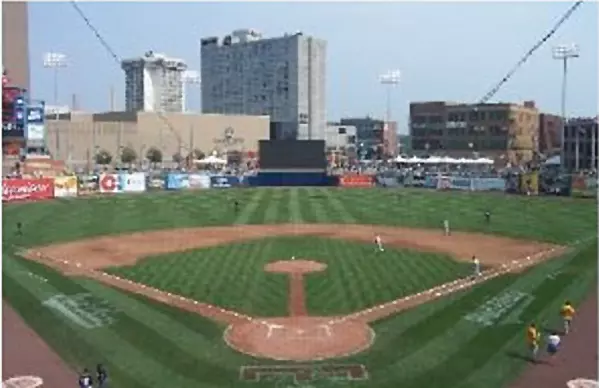 Fifth Third Field, the new home of the Mud Hens in 2002
Fifth Third Field, the new home of the Mud Hens in 2002
In 2002, the Mud Hens moved into Fifth Third Field, a custom stadium designed for baseball use in downtown Toledo. The new stadium, patterned along the new trend of "retro" stadiums, was built into the side of one of the existing downtown buildings, purposely lower than street level. This allows for views inside the stadium from outside its walls.
The Mud Hens were an instant success in their new home, winning the Western Division in their first year at Fifth Third Field. After two years of mediocre play (which coincided with the rejuvenation of the senior Tigers ballclub), the Mud Hens returned to their winning ways in 2005 and 2006, winning the Governors Cup in both seasons. The attendance problems, like the years of losing, also seem to be a thing of the past. In their first five seasons at Fifth Third Field, the Mud Hens drew no fewer than 500,000 fans, almost 200,000 more than they drew annually in the comparably sized Skeldon Stadium. In 2007, the "Roost" section of Fifth Third Field was voted by ESPN as having the best seats in all of minor league baseball.
With the parent ballclub, under General Manager Dave Dombrowski, having more success in the various Major League drafts, the future of the Mud Hens looks bright.
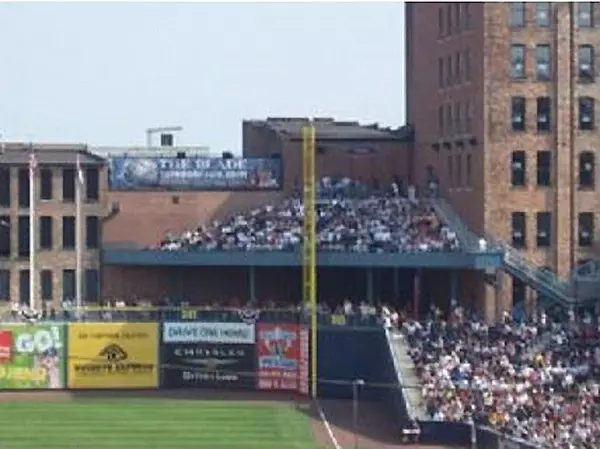 The Roost section of the Fifth Third Field
The Roost section of the Fifth Third Field
Major League Affiliates
<
|
Years |
League |
Affiliate |
|
1932 |
American Association |
Cleveland Indians |
|
1936-1939 |
American Association |
Detroit Tigers |
|
1940-1948 |
American Association |
St. Louis Browns |
|
1949-1951 |
American Association |
Detroit Tigers |
|
1953-1955 |
American Association |
Milwaukee Braves |
|
1965-1966 |
International |
New York Yankees |
|
1967-1973 |
International |
Detroit Tigers |
|
1974-1975 |
International |
Philadelphia Phillies |
|
1976-1977 |
International |
Cleveland Indians |
|
1978-1986 |
International |
Minnesota Twins |
|
1987-Present |
International |
Detroit Tigers |
Bibliography
Toledo Mud Hens
Benson, Michael. Ballparks of North America: A Comprehensive Historical Reference to Baseball Grounds, Yards, and Stadiums, 1845 to Present. McFarland Publishing. Jefferson, NC. 1989.
Blahnik, Judith and Phillip S. Schulz. Mud Hens and Mavericks. Viking Studio Books. New York. 1995.
Husman, John. Baseball in Toledo. Arcadia Publishing. Charleston, SC. 2003.
Longert, Scott. Addie Joss: King of the Pitchers. Society of American Baseball Research. Cleveland, OH. 1998.
O'Brien, John, Jerry De Bruin and John Husman. Mud Hen Memories. Perrysburg, OH. 2001.
Roger Bresnahan/Mud Hens Chapter of the Society of American Baseball Research. Blue Stockings to Mud Hens: A History of Professional Baseball in Toledo, Ohio. Roger Bresnahan/Mud Hens Chapter of the Society of American Baseball Research. Toledo, OH. 1998.
Archival material, including photographs, used courtesy of the Toledo Lucas County Public Library, Images in Time.
Negro Leagues in Toledo
Heaphy, Leslie A. The Negro Leagues: 1869-1960. McFarland and Company. Jefferson, NC. 2003.
Ribowsky, Mark. A Complete History of the Negro Leagues: 1884-1955. Birch Lane Press. New York. 1995.
Archival material, including photographs, used courtesy of the Negro Leagues e-Museum.
Essays
Baade, Robert A. and Allen R. Sanderson. "Cities Under Seige: How the Changing Financial Structure of Professional Sports is Putting Cities at Risk and What to Do About It," in Advances in the Economics of Sports, vol. 2. JAI Press. Greenwich, CT. 1997.
---- "Minor League Teams and Communities," in Sports, Jobs, and Taxes: The Economic Impact of Sports Teams and Stadiums. Donnelly and Sons. Harrisonburg, VA. 1997.
Johnson, Arthur T. Minor League Baseball and Local Economic Development. University of Illinois Press. Champaign, IL. 1993.
Kraus, Rebecca S. Minor League Baseball: Community Building Through Hometown Sports. Haworth Press. New York. 2003.
Quirk, James P. and Rodney Fort. Hard Ball: The Abuse of Power in Pro Team Sports. Princeton University Press. Princeton, NJ. 1999.
Rosentraub, Mark S. "Stadiums and Urban Space," in Sports, Jobs, and Taxes: The Economic Impact of Sports Teams and Stadiums. Donnelly and Sons. Harrisonburg, VA. 1997.
Web resources
Baseball Reference.com, accessed online at http://www.baseball-reference.com/.
ESPN. The Best of the Minor Leagues. http://sports.espn.go.com/travel/news/story?id=2909747
Negro Leagues e-Museum. http://www.coe.ksu.edu/nlbemuseum/history/teams.html
Toledo Lucas County Public Library
Glossary
Affiliation System - Each minor league team negotiates a contract with a "parent" club in the Major Leagues, i.e. the Mud Hens with their parent club the Detroit Tigers. These contracts usually run from one to five years. Since the players are technically the property of the parent club, all the minor league team pays for is the day- to-day operations and stadium costs for the team, with contracts being paid by the parent club.
The first "minor league" was the Northwest League of 1883-1884. The Toledo franchise was the champion of the charter season of the league. Toledo has had various affiliations throughout its nearly 120 years of baseball, including the Browns; Indians; Tigers; Twins; and Phillies. The Tigers have been a parent club on more than one occasion.
American Association - The American Association (minor league; not the precursor to the American League) would prove to be far more stable than any of the past leagues that Toledo participated in. With teams in cities such as Columbus, Louisville, Indianapolis, Kansas City, Milwaukee, and Minneapolis-St. Paul, the league would prove to be far stronger financially than any of the previous minor leagues. The American Association still exists today.
Blue Laws - Laws in the city of Toledo which prevented most businesses from operating on Sundays. The Blue Laws had been in effect prior to the founding of the Toledo franchise, but were not enforced until 1895. This would change with an affidavit filed by Ewing Street residents against the city for the running of the trolley to transport fans to baseball games. Then-owner Denny Long was able to subvert the law by playing Sunday games outside the city limits, but eventually was unable to continue to fight them. In 1896, the team left Northwest Ohio, relocated to Terre Haute, IN and was renamed the Hottentots. Ironically, trolley cars played a major role in Long choosing Terre Haute: he was promised 2 cents for every person that attended a Hottentots baseball game by a Terre Haute trolley car company.
Farm Team - Branch Rickey, the baseball innovator who de-segregated baseball by signing Jackie Robinson, also invented the minor league farm system. Rickey, then with the St. Louis Cardinals, devised a system that would allow him to train players in the minor leagues and then bring them up to help the parent club when needed. This was not looked upon fondly by Commissioner Kennesaw " Mountain " Landis, who fought the system on the grounds that it would destroy the minor leagues. Rickey would eventually prevail and the system is now in place, with multiple classes for every Major League baseball franchise.
Governors Cup - Awarded to the champion of the International League. The cup was originally devised when the Governors of Maryland, New Jersey, and New York along with the Lieutenant Governors of the Provinces of Quebec and Ontario, sponsored a trophy for the winner of the International League. A trophy has been awarded every year since 1933. The first version of the trophy, which was designed by Supervisor of International League Umpires W.B. Carruth and made of pure silver, is currently on display at the Major League Hall of Fame in Cooperstown, NY. The current trophy (won by the Mud Hens in 2005 and 2006) resides at the home of the winner.
International League - Minor League system that was initially created in 1884 out of a merger of three other minor leagues systems. The league has operated teams in Canada, the eastern seaboard of the US, the Midwest, and even in Havana, Cuba prior to Fidel Castro's rule.
Toledo Stadiums, 1883-Present
|
Seasons |
Teams |
Capacity |
Location |
|
|
Presque Island Park |
1883 |
Blue Stockings, Maumees |
N/A |
Now C&O Coal Docks |
|
League Park |
1884 |
Blue Stockings |
N/A |
13th and Monroe St. |
|
Tri-State Fairgrounds |
1884 |
Blue Stockings (Sunday games) |
N/A |
Oakwood and Upton St. |
|
Speranza Park |
1890 |
Maumees |
N/A |
Cherry and Frederick St. |
|
Bay View Park |
1891-1901 |
Swamp Angels, Mud Hens |
N/A |
3900 N. Summit St. (now a senior citizen golf course) |
|
Armory Park |
1901-1909 |
Detroit Tigers, Mud Hens |
N/A |
Speilbush Ave. |
|
Noah H. Swayne Field |
1909-1956 |
Iron Men, Mud Hens, Soumichers, Negro League Tigers, Crawfords |
14,800 |
Monroe and Detroit St. |
|
Ned Skeldon Stadium (formerly Lucas County Stadium) |
1965-2002 |
Mud Hens |
13,695 (1966) |
2901 Key St. Maumee, OH |
|
Fifth Third Field |
2002-Present |
Mud Hens |
10,000 (2002) |
406 Washington St., Toledo, OH. |
Swayne Field, (1909-1956)
![Swayne Field, Toledo, Ohio [approximately 1955] Swayne Field, Toledo, Ohio [approximately 1955]](https://toledosattic.org/images/jch-optimize/ng/images_exhibits_Baseball_swaynefield-ca1955.webp) Swayne Field, Toledo, Ohio [approximately 1955]
Swayne Field, Toledo, Ohio [approximately 1955]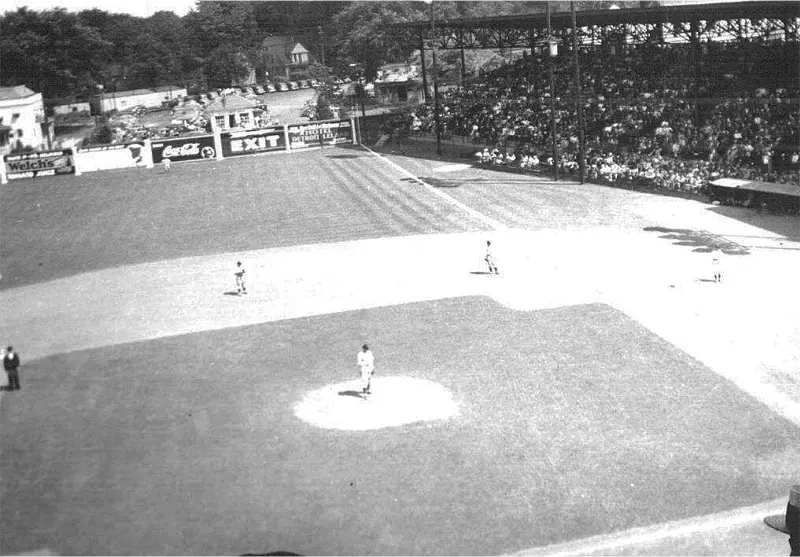 A photo of a game at Swayne Field, original home of the Toledo Mud HensSwayne Field, sometimes known as Mud Hen Park, was built in 1909 on land donated by Toledo businessman and baseball fan Noah H. Swayne. The financier of the project, then-owner William R. Armour, wanted the stadium to be the most modern in all of the minor leagues and did not spare a penny in trying to achieve this goal.
A photo of a game at Swayne Field, original home of the Toledo Mud HensSwayne Field, sometimes known as Mud Hen Park, was built in 1909 on land donated by Toledo businessman and baseball fan Noah H. Swayne. The financier of the project, then-owner William R. Armour, wanted the stadium to be the most modern in all of the minor leagues and did not spare a penny in trying to achieve this goal.
The first team to play at Swayne Field was the 1909-1913 Toledo Mud Hens. When owner Charles Somers moved the team to Cleveland to block the expansion of the Federal League, a lower level Michigan minor league team began playing at Swayne Field. Due to poor attendance for this lower brand of baseball, the stadium sat empty for the 1915 season.
Swayne Field was also home to the Negro League teams of Detroit and Toledo. From 1923 to 1955, the Tigers and the Crawfords both played there. The stadium was also used for high school baseball games and other local events.
The first game played at Swayne Field was on July 3, 1909. Thestadium would be the home of Casey Stengel and the 1927 Junior World Series Champions, but few other winning seasons. In 1933, the stadium added lights to allow for nighttime baseball.
 Swayne Field, Toledo's New Ball Park
Swayne Field, Toledo's New Ball Park
The field was rather large by today's standards, with the center field fence sitting 472 feet from home plate. Only one player, Sam Jethroe, was credited with hitting a ball out to dead center field. Behind the center field was the coal pile for the Red Man Tobacco plant. On a day when the wind was blowing in, the field was engulfed in the smell of unprocessed tobacco.
In 1955, with the Mud Hens wooed away from the city once again, in the name of "progress," Swayne Field was torn down and replaced with a shopping mall. Today, there are no reminders of what used to be the most modern and beloved minor league stadium.
Ned Skeldon Stadium (1965-2002)
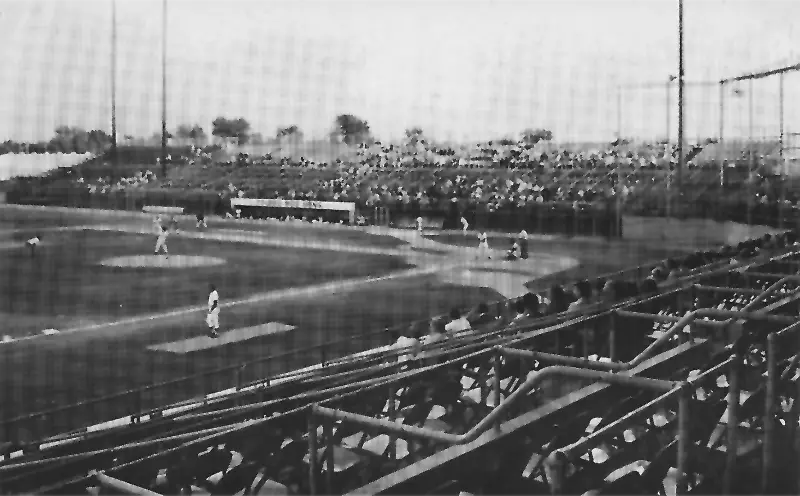 Lucas County Recreation CenterAfter a decade without baseball, Toledo was finally given another franchise in 1965 when the struggling International League team from Richmond, Va. relocated to the city. The Mud Hens were set to begin play in 1965 at the newly renovated Lucas County Stadium, which was located on the grounds of the Lucas County Recreation Center.
Lucas County Recreation CenterAfter a decade without baseball, Toledo was finally given another franchise in 1965 when the struggling International League team from Richmond, Va. relocated to the city. The Mud Hens were set to begin play in 1965 at the newly renovated Lucas County Stadium, which was located on the grounds of the Lucas County Recreation Center.
Lucas County Stadium was built using the grandstands from a horse track at the Lucas County Fairgrounds. These grandstands made up the seating behind the home plate dugout. The plan to bring baseball back to Northwest Ohio, as well as to build the stadium at the Lucas County Fairgrounds in Maumee, was devised by Ned Skeldon (then county commissioner) and a non-profit group created to bring baseball back to the Toledo area.
The stadium was known for its "fair" type atmosphere, as well as the long exposed walk of the players from the dugout to their respective locker rooms. This area proved to be an excellent place for fans to collect autographs from their favorite players.
In 1988, the name of the stadium was changed to Ned Skeldon Stadium, to honor the man who helped bring baseball back to Northwest Ohio.
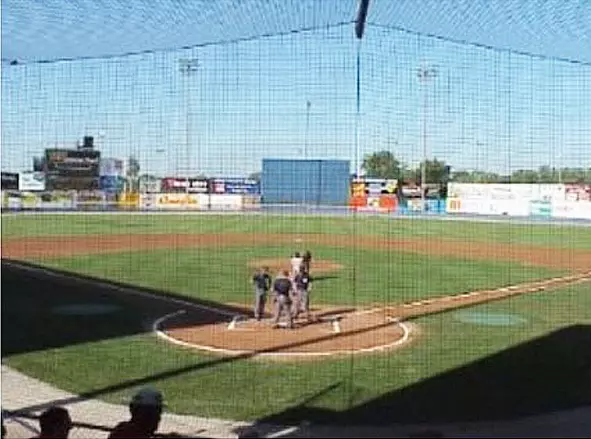 Ned Skeldon StadiumBy this time, what were once quirky charms of the stadium had grown into annoyances, as the stadium that was once known as one of the best in the minor leagues was now being compared to a high school facility. The Mud Hens played their final game in Ned Skeldon Stadium in 2002, officially moving the team back to Toledo and a new downtown location.
Ned Skeldon StadiumBy this time, what were once quirky charms of the stadium had grown into annoyances, as the stadium that was once known as one of the best in the minor leagues was now being compared to a high school facility. The Mud Hens played their final game in Ned Skeldon Stadium in 2002, officially moving the team back to Toledo and a new downtown location.
Today, Ned Skeldon Stadium is used for various activities, such as local baseball games and adult leagues.

